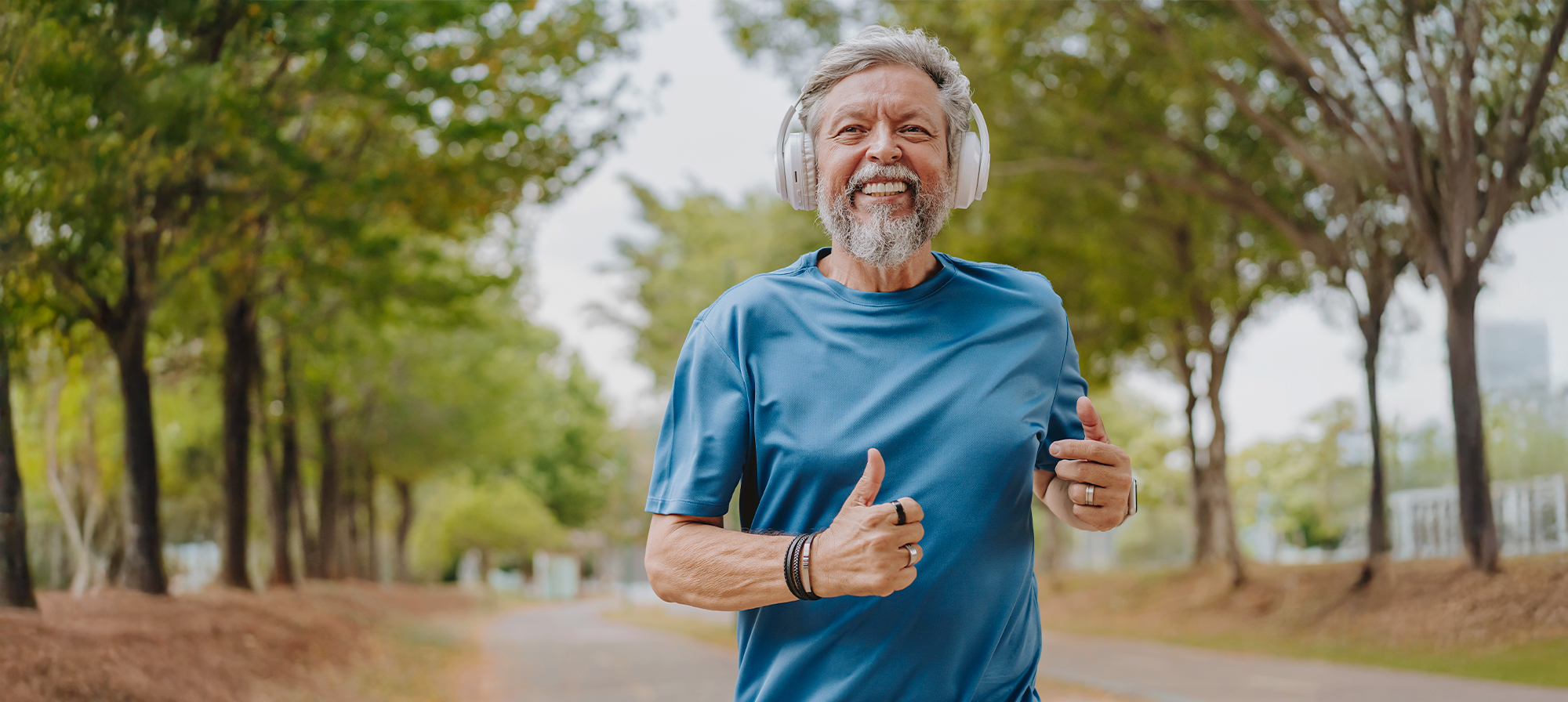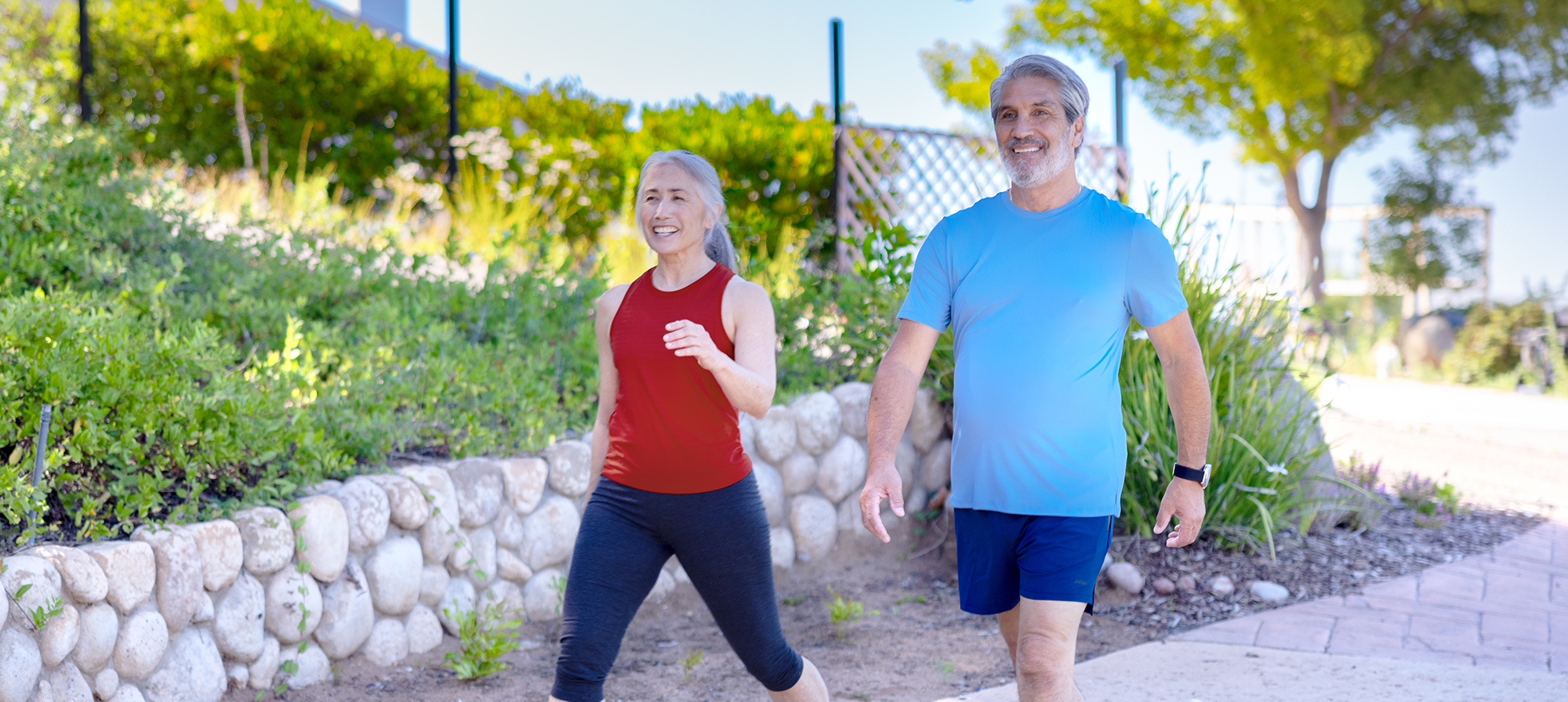Parks aren’t just for picnics. They offer a range of fun outdoor workout options—from biking and hiking trails to basketball courts, fitness classes, and more.
Spring is here! After a long winter, there’s no better time to get outside for some exercise. Your local neighborhood park likely offers an array of outdoor workout options, some of which you might not have thought of before.
Even a simple walk in the park can give you a good dose of exercise, nature, sunshine, and fresh air—all of which can boost your fitness, mood, and mental clarity.
If, on the other hand, you’re looking for a different and slightly more vigorous workout, many parks offer endless avenues for that, too. Just make sure to check with your doctor before starting any new workout routine.

Then, think about getting out and trying one or more of these 6 fun and invigorating workouts in the park:
1. Take your “walk in the park” up a notch.
You can easily turn your walk into a high-intensity interval training (HIIT) session. HIIT is not as intimidating as it sounds. You don’t have to be an uber-fit athlete to do it. You just need to mix some short bouts of slightly more vigorous exercise into your moderately paced walk. You can keep the pace and intensity at a level that’s right for you.
This might mean walking for 2 minutes, then stopping for a 30-to-60-second set of jumping jacks, modified push-ups, mountain climbers from a park bench, or jogging in place. The key is to dial up your heart rate to at least 80 percent of its maximum during these higher-intensity bursts.
Then rinse and repeat, alternating your 2-minute bouts of walking with 30 seconds of high-intensity intervals (in which you give it your full effort). How long should a HIIT workout be? If you’re new to working out, you might want to start with a 10-minute session of walking with 3 or 4 high-intensity bursts mixed in. You can gradually build up to a 15-, 20-, and then a 30-minute session.
HIIT is an effective way to gain strength and endurance more quickly than you would with longer, steady, moderately paced workouts. Plus, you may enjoy the added challenge of going “all out” during a HIIT session.

2. Create your own circuit in the park.
Circuit training consists of a mix of exercises. Each one targets a different muscle group, creating a full-body workout. Circuit exercises can be strength-training based. But you can also mix in some cardio, balance, and functional exercises.
Each exercise in a circuit is done for a set number of repetitions (e.g., 8 to 10 reps) or for a set time (e.g., 10 seconds to 2 minutes). You quickly move from one exercise “station” to the next, with little to no rest in between. The key is to keep moving and to go through all the stations at least one time. You can repeat the circuit of exercises 2 to 3 times, depending on your current fitness level.
Many parks have exercise stations with basic equipment, like step-up platforms, pull-up bars, and balance beams. If your park has these, you can use them for your circuit. Or you can create your own circuit training stations —with or without equipment.
Here’s how to get started. First, find an open, grassy space at the park to set up 8 to 12 exercise stations. You can mark each station with cones, dumbbells, mats, resistance bands, or other exercise equipment. You can also place a note at each station with the name of the exercise to do there.
Set up your stations in a square grid or as a large circle. If you’re doing the circuit with others, set each station up about 10 feet apart, so each person has space to move. Complete the first exercise, then move to the next station, until you’ve completed all of the exercises in your circuit.
Here’s just one sample of the circuit stations you could set up:
- Push-ups (modified, from your knees)
- Squats
- Overhead shoulder presses (with dumbbells)
- Core plank (on grass or yoga mat, from feet or knees)
- Jumping jacks or step jacks
- Side lunges
- Bent-over rows (with dumbbells)
- Alternating front and lateral raises (with dumbbells; don’t lift higher than shoulder level)
- Jogging or marching in place
- Triceps extensions (with dumbbells)
- Biceps curls (with dumbbells)
If you’re new to circuit training, you might want to work with a certified personal trainer to start. They can tailor a training session that is right for you and your current fitness level. And they can show you how to do each exercise safely and effectively. Or you might want to look for a group fitness class in the park that does circuit training.
Go at your own pace. Use lighter weights if you’re new to strength training or haven’t worked out in a while. You could bring a friend or 2 to run through the circuit together. Or do the workout solo, maybe with a music playlist to help keep you moving. Just make sure to warm up first with a brisk walk and cool down after with some static stretching.
 3. Hit the trail.
3. Hit the trail.
Many larger-sized parks have winding trails for walking, running, hiking, or biking. You could even give Nordic pole walking a try.
Look online for walking, jogging, or biking groups in your area to see if they use trail systems in any of your local parks. Or get a group of friends or neighbors together to create your own trailblazing meet-up group. If you use park trails alone, just make sure they are well-traveled by other parkgoers (not too isolated) and safe.

4. Find an outdoor fitness class in the park.
Outdoor workouts in the park are more and more common. You might notice groups of people doing various kinds of exercise when you drive by your local park. If one looks interesting to you, stop and ask the instructor for information. Or do an online search for outdoor fitness classes held in your city’s park.
You could join an outdoor boot camp class for a fun mix of cardio and strength training. Or you might want to try a peaceful yoga session. If you’re looking for something really relaxing, a group Tai Chi class could be great. You can enjoy the peaceful, flowing movements, performed under a grove of trees. Many parks also offer tennis and pickleball lessons and even high-energy hip hop, Polynesian, or Zumba dance classes.

5. Give recreational group sports a go.
Many parks have basketball and volleyball courts, softball fields, and frisbee or disc golf courses. Check with your local parks and recreation center to see if leagues or meet-up groups are inviting new members to join. Or gather some friends or neighbors together once a week to shoot some hoops or to play a pick-up game of softball.

6. Volunteer for your park’s landscaping or beautification group.
Working with a volunteer beautification group is an active way to both enjoy and enhance your park. Digging, raking, planting trees and shrubs, trimming, bagging cuttings, and other forms of landscaping make for a great workout. You’ll also be enhancing the natural beauty of your local park. You’ll learn new skills, too. Plus, research suggests that volunteering not only gives you a sense of meaning and purpose but also boosts your physical and mental health in big ways.
Take advantage of your area’s parks this spring. Working out in a beautiful, natural setting can give you a much-needed break from indoor workouts at home or in the gym. You’ll likely meet new people and make new workout friends. You can find new and different ways to work out that you haven’t tried before—all while getting outdoors to enjoy the warm spring weather.
Not a Silver&Fit® member? Learn more about everything the program has to offer, including more helpful healthy living tips like this, here on our website.
This information is not intended to take the place of regular medical care or advice. Please check with your doctor before using this information or beginning any self-care program. Images used for this article do not depict any members of the Silver&Fit program.
References
American Heart Association. (2024, April 22). Create a circuit home workout infographic. https://www.heart.org/en/healthy-living/fitness/getting-active/create-a-circuit-home-workout
Atakan, M.M., Li, Y., Koşar, Ş.N., Turnagöl, H. H., & Yan, X. (2021). Evidence-based effects of high-intensity interval training on exercise capacity and health: A review with historical perspective. International Journal of Environmental Research and Public Health, 18(13), 7201. https://doi.org/10.3390/ijerph18137201
Bácsné-Bába É., Ráthonyi G., Pfau C., Müller A., Szabados G.N., & Harangi-Rákos M. (2021). Sustainability-sport-physical activity. International Journal of Environmental Research and Public Health, 18(4), 1455. https://doi.org/10.3390/ijerph18041455
City Parks Alliance. (n.d.). Active parks, healthy cities: Recommendations from the National Study of Neighborhood Parks. https://cityparksalliance.org/resource/active-parks-healthy-cities/
Cleveland Clinic. (2023, September 27). High-intensity interval training: A HIIT for everyone with Katie Lawton, MEd. https://my.clevelandclinic.org/podcasts/health-essentials/high-intensity-interval-training-a-hiit-for-everyone-with-katie-lawton-med
Cohen, D. A., & Leuschner, K. J. (2019). How can neighborhood parks be used to increase physical activity? Rand Health Quarterly,16, 8(3), 4. https://pmc.ncbi.nlm.nih.gov/articles/PMC6557046/
Harvard Health Publishing. (2022, May 24). The health benefits of tai chi. https://www.health.harvard.edu/staying-healthy/the-health-benefits-of-tai-chi
Harvard T. H. Chan School of Public Health (2021, November). HIIT (high intensity interval training). The Nutrition Source. https://nutritionsource.hsph.harvard.edu/high-intensity-interval-training/
Keep America Beautiful. (n.d.). Beautification: Together, we keep America beautiful. https://kab.org/beautification/
Thoreson, A. (2023, August 21). Helping people, changing lives: 3 benefits of volunteering. Mayo Clinic Health System. https://www.mayoclinichealthsystem.org/hometown-health/speaking-of-health/3-health-benefits-of-volunteering
National Recreation and Park Association. (n.d.). Active parks! Increasing physical activity through parks, trails, and greenways. https://www.nrpa.org/globalassets/research/active-parks-implementation-guide.pdf
Levy-Storms L, Chen L, & Loukaitou-Sideris A. (2018). Older adults' needs and preferences for open space and physical activity in and near parks: A systematic review. Journal of Aging and Physical Activity, 26(4), 682-696. https://doi.org/10.1123/japa.2016-0354
Ramos-Campo, D. J., Andreu Caravaca, L., Martínez-Rodríguez, A., & Rubio-Arias J.Á. (2021). Effects of resistance circuit-based training on body composition, strength and cardiorespiratory fitness: A systematic review and meta-analysis. Biology, 10(5), 377. https://doi.org/10.3390/biology10050377
Wang, X., Zhou, Q., Zhang, M., & Zhang, Q. (2021). Exercise in the park or gym? The physiological and mental responses of obese people walking in different settings at different speeds: A parallel group randomized trial. Frontiers in Psychology, 12. https://pubmed.ncbi.nlm.nih.gov/34744896/
Wicks, C., Barton, J., Orbell, S., & Andrews, L. (2022). Psychological benefits of outdoor physical activity in natural versus urban environments: A systematic review and meta-analysis of experimental studies. Applied Psychology: Health and Well-Being, 14(3), 1037-1061. https://doi.org/10.1111/aphw.12353
This article was written by Gail Olson, edited by Stephanie Ruiz, and clinically reviewed by Jaynie Bjornaraa, PhD, MPH, PT, SCS, LAT, ATC, CSCS, CSPS, on February 5, 2025.





